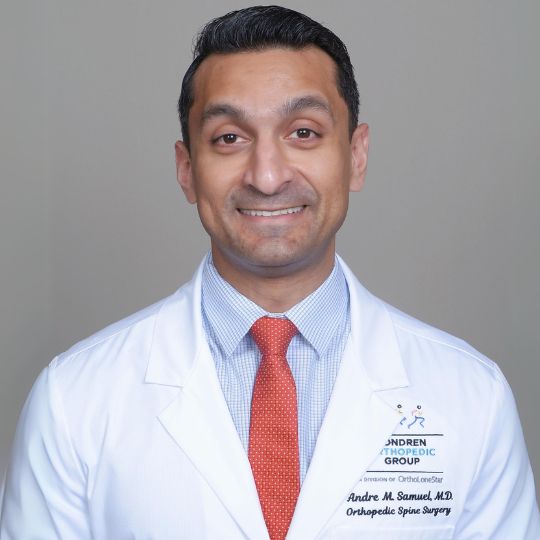ACDF Surgeon
Do you suffer from a herniated or degenerative disc in the cervical spine, or neck area? If so, you may benefit from a procedure called Anterior Cervical Discectomy and Fusion or ACDF. The main goal of ACDF is to alleviate pressure, reduce symptoms, and improve the patient’s quality of life. Dr. Andre M. Samuel, orthopedic spine surgeon in Clear Lake, Houston, and Sugar Land, TX, specializes in ACDF and can help alleviate painful symptoms. Contact Dr. Samuel’s team today!

What is ACDF?
Anterior Cervical Discectomy and Fusion (ACDF) surgery is a procedure designed to relieve pain and other symptoms caused by herniated or degenerative discs in the neck (cervical spine). When these discs located between the vertebrae bulge or collapse, they can compress the spinal cord or nerve roots, leading to pain, numbness, and tingling that can radiate from the neck into the shoulders, arms, and hands. The main goal of ACDF is to alleviate this pressure, reduce symptoms, and improve the patient’s quality of life. During the surgery, the affected vertebrae are fused with a bone graft to help maintain proper alignment and stability. The surgery has an 85-95% success rate, allowing patients to return to daily activities pain-free. Doctor Andre M. Samuel, orthopedic spine surgeon, treats patients in the Clear Lake, Houston, Sugar Land, TX area who may need an anterior cervical discectomy and fusion or ACDF.

Who is a candidate for ACDF?
Patients who undergo ACDF surgery usually suffer from herniated or degenerative discs, or other diseases affecting the cervical spine. The procedure may be an option if you’re experiencing persistent neck pain, numbness, tingling, or a drop in your quality of life, and conservative treatments have failed.
Consulting with Dr. Samuel is crucial to evaluate your medical history, symptoms, imaging studies, and overall health to determine if anterior cervical discectomy and fusion surgery is the right choice. As with any surgery, there are benefits and risks, which Dr. Samuel discusses with each patient before making any surgical decision. The best outcomes are seen in patients in good health, non-smokers, or those willing to quit.
How is an ACDF performed?
The patient is put to sleep under general anesthesia and won’t feel a thing. Dr. Samuel then makes a small incision in the front (anterior) of the neck and moves aside muscles along with the trachea and esophagus to get a clear view of the spine. Once the spine is accessible, Dr. Samuel uses special tools to remove the problematic disc – which is the discectomy part. After the disc is out, the space between the vertebrae is cleaned and prepared for the bone graft. This graft – either from the patient (autograft) or a donor (allograft) – is inserted in the space and often secured with screws and a metal plate, allowing new bone to grow and fuse the vertebrae. After everything is in place, Dr. Samuel puts the muscles, trachea, and esophagus back in place and closes the incision. The entire procedure can take up to two to four hours, depending on the number of levels treated, with additional time in the recovery room.
How long does it take to recover from an ACDF?
Recovering from ACDF (Anterior Cervical Discectomy and Fusion) varies from patient to patient. Typically, it includes one night in the hospital, where the pain is managed and a surgical drain is used to prevent a postoperative hematoma, or collection of blood. Once home, the drain is removed, and rest and light activity, such as walking, are encouraged for the first few weeks. Regular follow-up appointments with Dr. Samuel will help monitor progress. After four to six weeks, patients can increase activity levels and may be able to return to work. Physical therapy usually starts at this time helping the patient regain strength and flexibility.
The bone graft fusion process takes several months, so heavy lifting and neck-straining activities are off-limits. A full recovery can take six months to a year, with most people returning to normal activities and experiencing significant pain relief.
Following Dr. Samuel’s post-surgical instructions is important for the best outcome following ACDF. In addition, patients should maintain good posture, avoid smoking, and stick to regular exercise.


